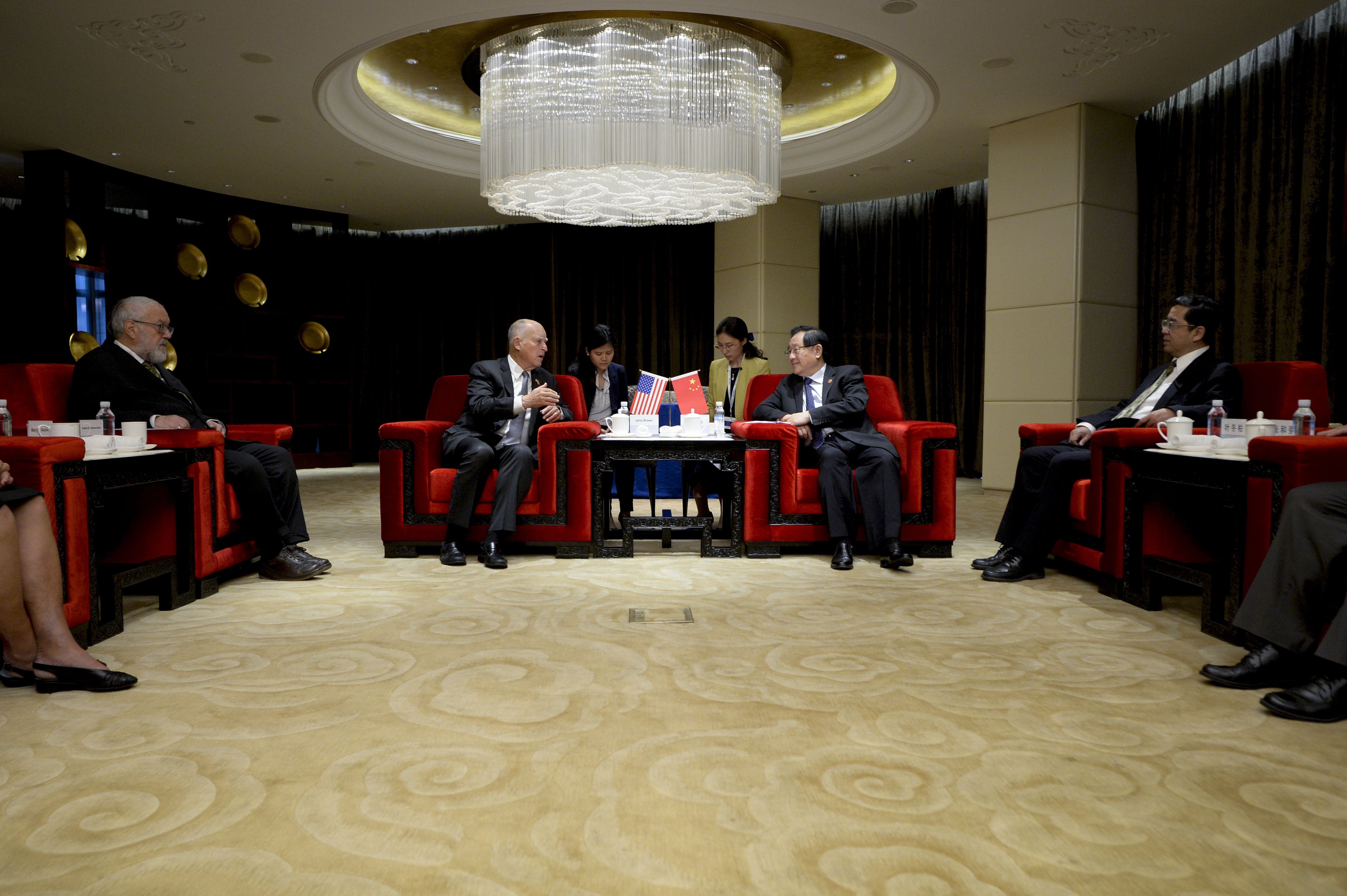Over the weekend, as the acting United States ambassador to China was resigning from his post following the Trump administration’s withdrawal from the Paris Agreement, California Governor Jerry Brown was over in the Chinese city of Chengdu, hanging out with a rotating cast of Chinese diplomats as part of a weeklong trip aimed at climate collaboration. He also made time to see the pandas at an eco-tourism park in Chengdu.
Chengdu recently won another prize from Washington: Bao Bao the panda, who for years captured hearts at the National Zoo before being claimed by the Chinese government. (Brown’s office was unable to confirm any face-time with Bao Bao while the governor is in China, saying through a spokesman that they “don’t have a breakdown of the furry residents who were in attendance.”)
But Bao Bao isn’t the only treasure the U.S. has recently ceded to China of late.
With his decision to withdraw the U.S. from the Paris climate agreement, President Donald Trump created a global leadership vacuum that China is stepping in to fill. As Scott Pruitt, the head of Trump’s Environmental Protection Agency, explained recently on Meet The Press, Trump thinks Paris is a “bad deal.”
“We don’t resist Trump just to resist him. We resist him because he’s a threat to our economic prosperity.”
Some Californians, meanwhile, think that Trump is a bad deal. “It’s unfortunate that President Trump is serving the clean energy leadership mantle on a silver platter to the Chinese,” says California Senate Leader Kevin De León. “[The Chinese] are more than happy to assume that leadership position.” De León and other Californian legislators are assuming it too, though they seem less than happy about it.
Even before Trump made his announcement last week, Brown was already gearing up for his weeklong trip across China, with stops in Sichuan and Jiangsu provinces as well as in Beijing. De León’s bill putting California on track for 100 percent renewable energy by 2045 had just passed the state senate.
This week, Brown is off building the diplomatic connections that the president should be making. While in China, Brown is sharing advice on zero-emission vehicles and air pollution control, hatching deals on electric vehicles, and seeing where other interests align.
Like his Chinese counterparts, Brown’s engaging in this diplomacy not out of kindness or magnanimity—and not because he want to pick up any slack for Trump’s White House. He’s doing it because Californians have determined it’s in their self-interest.
“We don’t resist Trump just to resist him,” De León says. “We resist him because he’s a threat to our economic prosperity.” The clean power sectors employ more than half a million Californians, according to recent estimates from the Advanced Energy Economy Institute. That’s more people than the coal-mining industry employs nationally by an order of magnitude—though you wouldn’t know it if you’re only listening to Pruitt and the White House.

(Photo: Kim/Flickr)
Trump’s Paris announcement doesn’t change California’s pre-existing interest in aggressive renewable policy, De León says, but it certainly heightens the sense of urgency. At times it can even feel as though California’s leaders are trying to out-urgent one another: Last week, as De León and other senators signed a letter imploring the governor to partner with Canada and Mexico for their own climate summit, Brown was already heading out the door to China.
This week, Brown is meeting with top officials around China to restore diplomatic bonds where he thinks Trump has damaged them. “We need a very close partnership with China,” Brown told President Xi Jinping in a 45-minute meeting on Tuesday. And on Wednesday, Brown met with Christiana Figueres, the former executive secretary of the United Nations Framework Convention on Climate Change, to affirm the commitment of global sub-national governments—like California’s—to reducing greenhouse gas.
Mostly though, Brown is busy pursuing his state’s business interests with China, as Chinese policymakers and executives pursue theirs with him. Quite often, those interests are compatible: California is a huge consumer of solar energy, and China’s solar-electric industry brought prices down 80 percent between 2008 and 2013. Brown’s obsessed with bringing high-speed rail to San Francisco and Los Angeles; China has two-thirds of the world’s high-speed rail already built and could help Brown power trains in California with low-cost solar.
Brown’s also looking to China for the future of electric cars. At an event in Nanjing this week, addressing his goal of getting four million to five million electric vehicles on California roads by 2030, he said: “We aren’t going to get there until Chinese businesspeople, Chinese government leaders make it a priority to develop batteries and electric cars. And we will too.”

(Photo: Wang Zhao/AFP/Getty Images)
At first glance, California and China make for strange political bedfellows; at second, they make a lot of economic sense—certainly more than many people (notably Trump) realize. As California billionaire environmentalist Tom Steyer explains it to me, California and China are rightful “frenemies.”
“We actually are working together to solve climate problems but we’re doing it in the context of a capitalist system where it’s competitive,” Steyer says of the approach. “That’s normal, but it’s completely different from the way the Trump administration sees things. Global problems are better handled together. Even if under the surface there is competition, that doesn’t mean we can’t mutually benefit each other.”
That Chinese officials recently relied on California’s guidance in developing a planned emissions trading system, with China making itself useful to California on many occasions, doesn’t square with Trump’s core argument for rejecting the agreement. And it certainly doesn’t square with Trump’s claim that the non-binding agreement would impose “draconian financial and economic burdens on our country.” (Has anyone explained the term “non-binding” to him?)
Before jetting off to China, Brown said that “Mr. Trump is wrong on the facts, wrong on the science, wrong on the economy.” A careful parsing of Trump’s speech by Washington Post fact checkers suggests the president was either woefully misinformed or else given over to pure fabrication.
The good news is Americans aren’t swallowing Trump’s nonsense. A recent Washington Post-ABC News poll found widespread skepticism toward Trump’s argument that withdrawing from the Paris accord will help the U.S. economy: Forty-two percent of respondents say the decision will hurt the U.S., and 20 percent say it will make no difference.
Back in California, De León seems just as puzzled as the Post‘s fact checkers. “We’re trying to understand ourselves what Trump is talking about,” he said, “because we don’t have confidence that he knows.”





